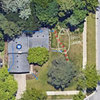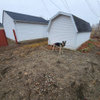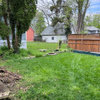I know that cold weather vegetables like cold weather
(they grow better in it, more likely to germinate in it,
taste better in it, etc.). However I know that even cold weather
vegetables have their limits; some are more hardy than others.
The more "tender" cool weather veggies (less hardy) will
die if planted in weather that is too cold.
Recently I was thumbing through a seed catalog.
According to the description of some of the vegetable
seeds, some varieties are "exceptionally tolerant of cold weather".
When gives instructions with how to grow these varieties, it says
that "they can be planted in early spring".
However what constitutes as early spring in northern Michigan?
(I live in the upper part of the lower peninsula). Also in comparison to
temperatures in "normal spring" (which where I live doesn't start until
about May, and that's if the winter has been mild) "mid spring" and
"late spring" what is the difference in temperature ranges with each
"season" of spring and in comparison to "early spring"?
I'd like to plant the cool weather vegetables that are hardier as early as
possible, however I don't know how early I can do that (as in when there
is still snow on the ground and the seeds will germinate and the plants
will survive). I'd basically like to be able to plant them as early as
possible without killing what I'm planting; they will be direct sown outside.
Also I know people will probably (this is preemptive, not trying to make assumptions,
sorry if it comes off that way as it's not my intent) suggest using floating rows/
row covers, cold frames, greenhouses, etc. I have limited space and in
addition I will be doing container gardening. As a result, I don't know if
it would even be feasible to use row covers. About the only thing that
would be a "for-sure" possibility would be bottle cloches (pop bottles with vents cut
in the sides for ventilation-essentially mini greenhouses).
Below is a list of the varieties I found in the catalog, that, according to the description
(as stated above, not trying to be reptitive, just clarifying) are very tolerant of
cold weather and I'm assuming are hardy as a result.
~NOTE: This isn't a "generic" seed catalog. To my knowledge, the seeds in the catalog
are bred and designed specifically for short climates that are cold (a.k.a. Northern climates).
Also some of the vegetables I'm not that familiar with (with cooking, eating, and growing; I know
a little bit about them, but don't really know how to grow them, as I don't have experience
with doing so, because I've never grown them before). I have included the names of
the seed varieties according to the catalog, as well as what type of vegetable it is.
Windsor (Fava Bean, also known as broad bean; in regards to growing it, it doesn't like hot weather;
the catalog says it prefers a cool climate; don't know too much about it.) It doesn't say that
it's exceptionally cold tolerant, but the reason I'm including it is because it prefers a cold
climate; don't know if this means it can be grown in early spring.
Spring Raab (Broccoli Raab; again don't know too much about it, I just know it's sort of
similar to broccoli and commonly used in Italian cuisine; know nothing about growing it).
I don't know if it's feasible to grow this in early spring weather; I just included it because it
says "spring raab" and although I know nothing about growing it, I do know it grows
best in cold weather.
Arcadia, F1 (Broccoli)
Alcosa (Savoy Cabbage; "mini" heads in comparison to other traditional varieties
of cabbage)
Napoli (early maturing variety of carrot)
230 Snow Crown F1 (Cauliflower; yes I know traditionally cauliflower isn't
considered a "hardy" winter veggie, at least so I've heard; however this variety according to
the catalog has been bred for "very cold temperatures")
Clodia (Endive; not too familiar with it; just know that according to the catalog,
this variety is ideal for use in salads; I know it's a European green that's
also known as Chicory)
Clio (Dandelion green; not too familiar with it, know nothing about growing it;
a mildly bitter green common in European culture, particularly Italy)
Chioggia Red Preco No.1 (Raddichio; know it's common in salads in Europe,
and also common in mesclun [salad greens mixture] )
512 Kyona Mizuna (Japanese green with fringed, lace-like leaves)
388 Claytonia (also known as miner's lettuce; leafy green thing
common in salads)
305 Starbor F1 (early-maturing variety of kale)
2190 Top Bunch F1 (early-maturing variety of collard greens)
419 Vit (Mache also known as lamb's lettuce and corn salad;
a leafy green thing common in Europe; commonly used
in mesclun [salad green mixtures) and salads)

















johnnyrazbrix
Related Discussions
Newbie and very confused. Help!!!
Q
seeds from Rudbeckia Irish Eyes
Q
2005 prius---bluetooth or not?
Q
Need help identifying this fuxture
Q